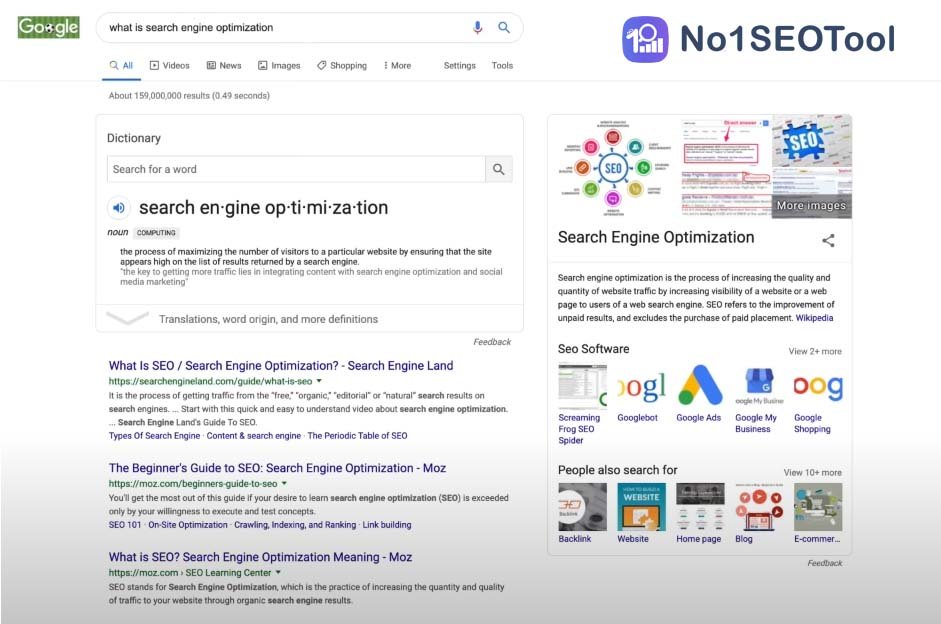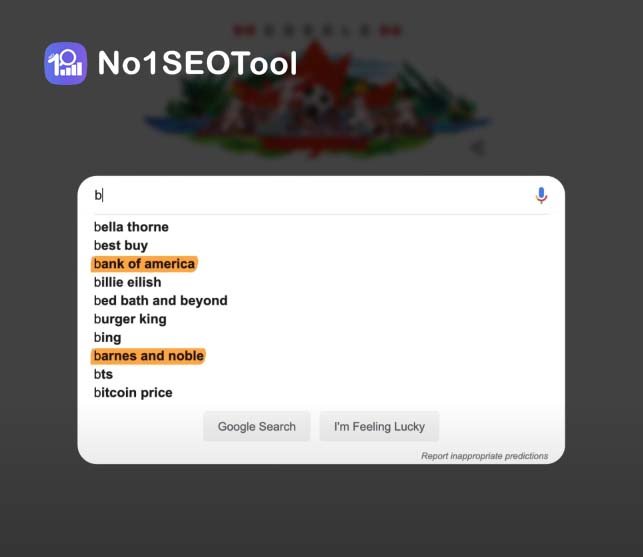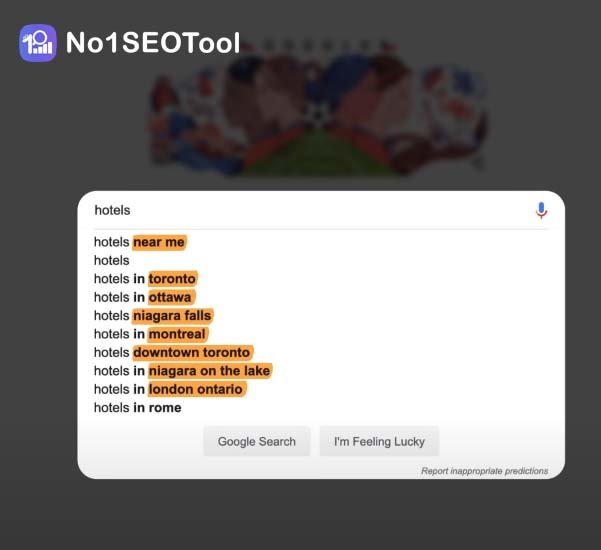Table of Contents
What is SEO? and how does it work? This Article explains how search engine optimization works and how you can optimize your website to be discovered in search engines like Google.
What is SEO?
SEO stands for search engine optimization. It’s the practice of optimizing content to be discovered through a search engine’s organic search results. Think of a search engine as a filing system in a library. The library has potentially billions of books with hundreds of trillions of pages.

So let’s say you want to find information on health supplements. The search engine will then look through all pages in its index and try to return the most relevant results.
Google Search Engine
Now, the first search engine you’re probably thinking of is Google. But there are tons of other search engines you can optimize your content for.
 For example, YouTube SEO is the process of getting traffic to your videos in YouTube’s organic search results.
For example, YouTube SEO is the process of getting traffic to your videos in YouTube’s organic search results.
Amazon SEO is the same, but you’re optimizing your product pages to get free organic traffic. And of course, Google SEO, is the process of optimizing your website to rank on Google and drive more traffic to your web pages.
Now, search engines use sophisticated algorithms and technology to return the best results for any given query. Nobody knows exactly how these algorithms work, but we have clues, particularly for Google, so we can make some optimizations.
Why should you incorporate SEO into your marketing strategy?
Well, there are 3 major benefits of search engine optimization that attracts marketers from all over the world. #1. Traffic from your SEO efforts are free. #2. Your traffic will be consistent once you’re ranking high. And #3. You have the opportunity to reach massive audiences, you wouldn’t have access to otherwise.
Now, since every search engine has unique algorithms, you and I won’t be able to cover how each of them works. And for that reason, we’re going to be focusing on how Google works to rank pages since it’s the largest search engine and the one that we here at Ahrefs have the most information on.
How does Google work?
Well, there are two main terms you need to understand. These are Crawling and Indexing.
Crawling and Indexing
To actually attain information, Google uses crawlers, also known as spiders, which gather publicly available information from all over the web. The spiders start with a list of URLs, which they may have previously crawled or found in sitemaps. These are called seeds. They then follow the hyperlinks on the pages from the seeds and then crawl those newly discovered pages. And this process goes on and on, allowing them to build a massive index of information. They then take all of this data back to Google’s servers to be added to what they call, their “search index.”
keywords and Knowledge Graph
Their algorithms then work by taking things like keywords and content freshness to categorize queries so they can return the most relevant results to searchers in a fraction of a second. Now, Google isn’t just about matching keywords within a search query. They’ve created something called the “Knowledge Graph,” which according to Google, “goes beyond keyword matching to better understand the people, places and things you care about.”
Some examples

I’ll show you some examples of this in a bit. For now, let’s dig into the details of how their search algorithm works. Again, Google’s goal is to sort through hundreds of trillions of web pages within their search index and find the most relevant results in a fraction of a second. On Google’s “How Search algorithms work” page, they say that they look at the words of a searcher’s query, relevance and usability of pages, expertise of sources, and your location and settings.

These ranking factors aren’t linear, but they’re weighted depending on the nature of your query. As an example, they mention that “freshness” of content plays a bigger role in answering queries about current news topics. However for definition-based queries like “what is search engine optimization?,” freshness wouldn’t play as large of a factor, since this core definition itself hasn’t really changed.
Search Quality Raters
In addition to technology based innovations like artificial intelligence and machine learning, Google also uses a group of people to manually assess how well a website gives people who click on the results what they’re looking for. These people are called, “Search Quality Raters.” Rest assured that these aren’t people at Google manually moving your web page around in the search results because they like or don’t like you. These people don’t directly impact rankings, but rather helps Google benchmark the quality of their results.
Understand the meaning of a search query
For now, let’s dig deeper into a few broad categories of Google’s ranking factors. The first and most obvious thing they need to do is understand the meaning of a query.
Some examples of how google search work

For example, if you search for “slow cooker recipes,” what do you expect to see in Google’s search results? Probably a list of recipes, right? And that’s how Google interprets the query too.

But what if you just search for the word “slow cooker?” What would you expect to see? After keying that into Google search, you’ll see product listings and ecommerce category pages.
Google is able to interpret that someone searching for this phrase likely has the intent to purchase the appliance rather than look for recipes in that time. Understanding the meaning of a query comes down to language. Google has created language models to decipher strings of words they should look up. They understand that when you type “slow coker”, that you’re actually looking for “slow cooker.”

They also understand synonyms. For example, looking at the search results for “how to make a website,” you’ll see that they’ve bolded synonyms within the search results. Beyond language, search algorithms also try to understand the type of information you’re looking for.

For example, if you search for “ps4 unboxing,” you’ll see that the top 10 Google search results are chalk full of pages from YouTube. They understand that anyone searching for an unboxing tutorial, would likely prefer video content over text or images.

Whereas a query like “map of New York,” will show you image results as well as a widget from Google Maps.

Now, what about a query like, “best Mexican restaurant?” You’ll see that Google shows restaurants that are close to your location, despite not entering a city name in the query. And that’s because someone searching for this isn’t going to fly halfway across the world for lunch.

Another part of interpreting a searcher’s query comes down to freshness. For example, if you search for “Donald Trump,” Google understands that people likely want recent news, over biographies. So they give priority in their top stories widget from reputable sources.

They also understand that if you’re looking for something like “best headphones,” that you likely want fresh information since new models and manufacturers are always on the rise. And you can identify this right in Google’s search results seeing as all top ranking pages have the current year in the title.
Most, if not all of the things we’ve covered here can be summed up into what SEOs often refer to as “search intent,” which basically means the reason behind a searcher’s query. This is arguably one of the most important things to master as an SEO. If you’re unable to match the searcher’s intent, in terms of content type and format, your chances of ranking are slim. But there are additional layers to understand how Google works.
Understand how Google identifies relevance through content
This leads us nicely into how Google identifies relevance through content on a web page. In the most basic form, search engines will look at the content of the page to see if the words on that page are relevant to your query. But they’re sophisticated enough to go beyond “exact match keywords.” Google understands related keywords too. A page increases in relevance with other semantically similar keywords.

For example, if you have an article on how to get a driver’s license, you may have subsections on licensing for cars, motorcycles, and buses. These are all automobiles and should have keyword overlaps that help connect the topic as a whole. For example, “road,” “driving,” “seatbelt,” “safety,” “exam,” and “test,” these would all be semantically relevant keywords that can help search engines better understand what your post is about.

Another example would be if you were creating a post on “the best luxury watches.” Now, I want you to think of a 5-letter word that pops to mind when it comes to luxury watches. Let me help you out a bit. Rolex. And if you look at the content of the top 10 ranking pages, you’ll see that they all include that brand, other popular luxury brands, and likely have watch related jargon like “bezel,” “bridge,” or “chronograph.” Rather than returning results that have “best luxury watches” written 100 times on the page, Google can see which pages are the most relevant to the searcher’s request. And Google confirms this by saying:

“These relevance signals help search algorithms assess whether a webpage contains an answer to your search query, rather than just repeating the same question.
Learn how Google identifies the quality of content
Another factor Google looks at is the “quality of content.” Google tries to prioritize and rank the most reliable sources. While “quality content,” is impossible to objectively nail 100%, they use 3 broad categories to help identify quality pages. These are, expertise, authoritativeness, and trustworthiness on a given topic; Also known as EAT.
Backlinks in SEO
 One signal that Google mentions are getting websites to link to your content, which SEOs call backlinks. Links build up a page’s “authoritativeness,” which is outlined in Google’s famous patent on PageRank. From a general view, think of backlinks as votes. When people link to your pages, they’re essentially vouching for your content and telling their readers that they should check out your page for more information. Now, to prevent people from “gaming” the system, Google uses spam algorithms to try and identify deceptive or manipulative behavior.
One signal that Google mentions are getting websites to link to your content, which SEOs call backlinks. Links build up a page’s “authoritativeness,” which is outlined in Google’s famous patent on PageRank. From a general view, think of backlinks as votes. When people link to your pages, they’re essentially vouching for your content and telling their readers that they should check out your page for more information. Now, to prevent people from “gaming” the system, Google uses spam algorithms to try and identify deceptive or manipulative behavior.
link exchanges
One example would be “link exchanges,” meaning you contact other webmasters and ask them to link to you. And in return, you’ll link to them.
How does Google consider the usability of webpages?
Another factor Google considers is usability of webpages. Google wants to show results that keep their searchers happy. And this goes beyond providing the “right” content for the query. There are a couple of confirmed ranking factors that relate to usability.
Page speed in SEO
The first is page speed. Google found that as page load time increases, the probability of bounce, or the chance of someone leaving your website without visiting another page, goes up dramatically. And it makes sense. If Google were to show slow-loading pages that result in bounces, then that dissatisfaction would increase amongst their users. As a result, Google announced in 2018 that page speed will become a part of their mobile search ranking algorithm.
Mobile friendliness in SEO
The second usability factor is “mobile friendliness.” Today, websites should appear correctly no matter what device you’re on and no matter what browser you’re using. This is often referred to as “responsive design.” Google has shifted to “mobile first indexing.” This means that they’ll predominantly use the mobile version of the content for indexing and ranking. And as of July 1, 2019, all new websites will be “mobile first” by default. All of these things and many more factors can be summarized into user experience. Google wants to return results that are both relevant and provide a solid user experience.
How does Google work with personalized data?
A very cool and somewhat controversial way that Google works is through personalized data. Google keeps track of your location, past search history, and search settings to “tailor your results to what is most useful and relevant for you in that moment.” But as many people are becoming aware of privacy issues on the internet, this may leave you extremely satisfied or perhaps, on edge.
Examples

Let’s look at a few examples of how personalization affects your Google searches. I’m in Toronto, Canada, so when I type in the letter “b,” Google provides relevant search suggestions to my location like “blue jays,” which is our baseball team, and “BMO,” which is a major bank in Canada.

Now, if I change my IP address to one in Chicago, then you’ll see very different results like “bank of America,” and “Barnes and noble,” which is a popular bank and bookstore respectively.

Now, let’s look at how they tailor search suggestions based on previous searches. Let’s say I want to find “hotels in barcelona.” I’ll start typing in “hotels,” and let’s say that I actually changed my mind halfway through the search. Take a second and look through the results. You’ll see that they’re all tailored to my current location.

So let’s I want to search for things to do in Barcelona, so I can choose a hotel around that location. Now, I’ll search for “What to do in Barcelona. Now, it’s time to find a hotel. So if I start typing in “hotels,” you’ll see that Google’s first autosuggestion is, “hotels in Barcelona,” which as you saw before was not the case.
Conclusion.
These are just a few basic ways Google works. And it’s absolutely critical that you understand this when you’re learning SEO. By understanding how search works, you can begin optimizing your pages with some level of direction.

